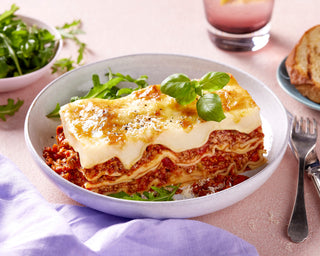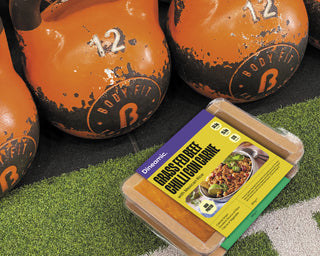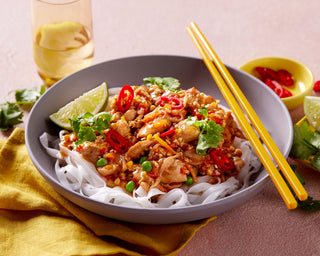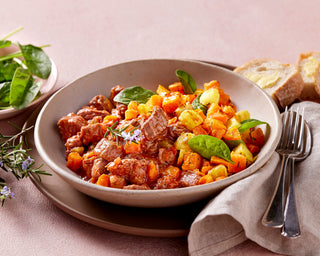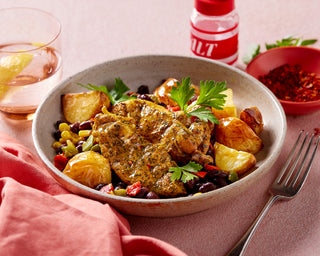This week Karen Inge shifts her focus to protein, as part of our ongoing look at the Dineamic Healthy Eating Plate.
What does’ Protein Power ‘mean to you?
Is it loading up with massive tubs of whey protein powders, or lining up rows of amino acid supplements in your gym locker, or perhaps gulping down litres of protein shakes to fuel your punishing body transformation program? Or does ‘Protein Power’ mean eating more protein rich foods to help stimulate muscle growth, lose fat and develop a leaner, stronger, high performing body as well as repairing damaged tissues and supporting the overall functions? While it is true that athletes who undertake hard strenuous training sessions have higher protein needs than normally active people, they usually can meet their protein requirements simply be meeting their energy requirements. In other words, if their diets are well balanced, they can meet their protein needs by eating protein rich foods. This might surprise you but in most cases there is no need for protein supplements. And the other bonus besides saving money is that food tastes so much better than supplements. Well that’s my opinion anyway! Let’s take a closer look at some of the benefits of protein, where to get it and how to add more protein to your menu.
What is Protein?
Proteins, made up of amino acids are the building blocks of our bodies. Muscles, skin, hair and blood cells, as well as hormones, enzymes and antibodies, are all made from various combinations of amino acids. Some amino acids are actually made by our body but others must come from the diet. These are called essential amino acids. Animal protein contains all of the essential amino acids and is referred to as high biological value (HBV) protein, meaning that these animal sources of protein contain large amounts of essential amino acids in a form that are easily digested. Isolated soy protein is also considered to be of high biological value. Other plant sources of protein are still very useful and for vegetarians as they are the major source of protein in their diets. So it is important for vegetarians to ensure that they vary their sources of protein to ensure of good mix of amino acids
Protein-rich foods
- Red meat like beef, lamb, venison, kangaroo
- White meat like pork, rabbit
- Poultry
- Fish & shellfish
- Milk, cheese & yoghurt
- Eggs
- Legumes
- Tofu
- Nuts & seeds
Protein – nutrient dense
These protein-rich foods also provide a variety of other nutrients, including many vitamins like Vitamin B12 and minerals including calcium, iron and zinc. Eating too little protein can put you at risk of nutritional deficiency. Groups at risk are vegetarians especially vegans, pregnant and lactating women and dieters.
Protein – for weight loss
The latest research is actually showing benefits for higher protein intakes for weight loss. Studies where subjects consumed diets providing 25-30% of energy (i.e. 25-30% of the total kilojoules) from protein resulted in more weight loss, compared with those following high carbohydrate diets providing only 12-15% of energy from protein. Total fat intake was the same. Those on higher protein diets had greater total and abdominal fat loss, than those on diets with less protein.
Protein – for muscle growth
For those people wanting to gain muscle, the amino acid leucine plays a very important role. One of the best sources of leucine in the diet is dairy products in particular the whey protein which stimulates muscle synthesis. This may explain the heavy reliance of some athletes on whey protein powders. It is interesting to note that one of the best food sources of whey protein is Ricotta cheese. Don’t forget that it’s all well and good to eat more whey protein to build muscle but unless you’re doing some strength or resistance training you won’t see much difference.
Protein – high satiety
Protein-rich foods are more filling than many other foods. This means that higher protein diets may be easier to follow for longer as they may be more satisfying. Most people will know how hard it is to lose weight if you’re always hungry. Think about eating a slice of toast with vegemite for breakfast– not very filling, right? Try mushrooms on toast– more filling but doesn’t really keep you satisfied for long. However adding some protein in the way of an egg, baked beans or avocado to that toast will increase your feelings of fullness and keep you satisfied for longer.
Protein – GI lowering
Although protein-rich foods eaten alone have little effect on blood glucose levels, protein can slow the rate at which carbohydrate is digested and absorbed into the blood stream. So protein can essentially lower the glycaemic load of a meal. Let’s consider, lean beef stir-fry with rice. Rice has a high glycaemic index which means it is causes a rapid rise of glucose in the bloodstream resulting in the pancreas needing to produce more insulin to keep the blood glucose level in control. However when the rice is topped with a protein food such as lean beef the glycaemic load (GL) of that meal is significantly reduced. There are a number of benefits associated with a reduced glycaemic load such as increased satiety, increased fat burning and less insulin resistance, thereby decreasing the risk of diabetes and cardiovascular disease.
Protein – for a good mood
One of the amino acids, tryptophan, found in milk, poultry and other high-protein foods appears to improve mood. Tryptophan produces serotonin, which functions as a neuro-transmitter carrying messages to the brain and helping you feel calmer and more relaxed. That probably explains the rationale for the glass of warm milk before bed.
Adding Protein Power to your meals
At breakfast:
- Top wholegrain toast with a poached egg or baked beans
- Add a large dollop of yoghurt to berry bircher muesli
- Add some chia seeds to a yoghurt green smoothie
- Add some quinoa to your minestrone soup
- Add some chick peas to the pita pocket stuffed with salad
- Add avocado or a hard boiled egg to your salad sandwich
- Add tuna or salmon to your pasta with napoli sauce
- Grill a lean steak and serve with vegetables and salad
- Add tofu or chicken to your vegetable stir fry or vegetable risotto
- Enjoy a bowl of yoghurt with seasonal fruit or a fruit smoothie made from milk or soy.
- Nibble on some nuts with your dried fruit
- Use ricotta cheese or hummus as a dip with vegetables


